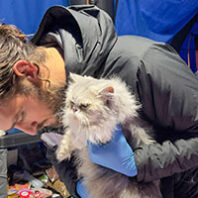
Companion Animals


Keep your pets safe in the summer heat

Videos: Agility dog health and competitions
Agility dogs perform amazing physical feats but like all athletes, there are risks.
Debra Sellon, a professor at the Washington State University College of Veterinary Medicine, owns and trains agility dogs. She recognized the risks to dogs and cofounded the Agility Dog Health Network.
Sellon explains more about agility dog health below, followed by videos of competitions, how to get into agility dog training, and a dog that’s, well, not really following the agility rules.
Agility Dog Health Network (WSU Veterinary Medicine)
More about the Agility Dog Health Network
Best of 2022 Masters Agility Championships from Westminster Kennel Club (FOX … » More …

Hoop dreams

Help pets of Ukrainian refugees
The flow of refugees from the invasion and conflict in Ukraine isn’t just a human crisis.
Dogs, cats, and other pets often make the journey with their people, and they have their own needs. Pets endure the stress of travel, unknown places and faces, and dangerous situations.
In turn, though, they give comfort to Ukrainians forced to flee their homes.
“When your world is turned upside down, but you have the unconditional love of a pet, that is going to be what helps. That bond is unbreakable,” says Marty Becker (’80 DVM).
Becker and others are helping with pets of Ukrainian refugees in Romania, Poland, … » More …

Stacy Slade

No pathologist needed: an Iditarod blog
When a colleague contacted me in fall 2019 asking if I wanted to participate as a pathologist in the 2020 Iditarod, I didn’t really know what to expect. But I knew it sounded like something I wanted to do.
The race involves teams of sled dogs running approximately 1,000 miles in 10 to 14 days. Typically, more than 50 veterinarians are stationed at about two dozen checkpoints to monitor and care for the animals. Among these veterinarians are one or two veterinary pathologists who are there to do a postmortem examination, called a necropsy, in case a dog dies on the trail. … » More …

Compassion comes naturally

A race at the top

